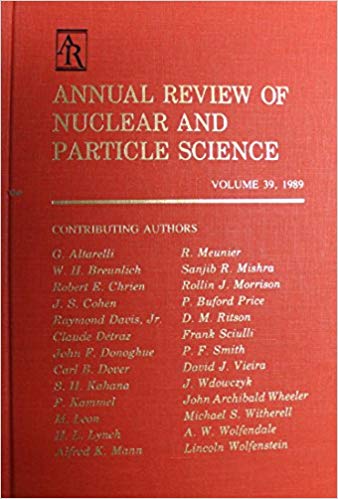规范层次问题的新解
IF 9.1
2区 物理与天体物理
Q1 PHYSICS, NUCLEAR
Annual Review of Nuclear and Particle Science
Pub Date : 2023-09-25
DOI:10.1146/annurev-nucl-102422-080830
引用次数: 1
摘要
对希格斯粒子质量进行量纲分析,可以预测出新的物理相互作用,这种相互作用产生的质量为1tev。这些相互作用可能是什么的问题被称为规范层次问题。在过去的几十年里,解决这个问题一直是粒子物理学的中心目标。传统的解决方案引入了质量低于1tev的新粒子,但这一预测现在受到了实验的挑战。在这篇文章中,我回顾了最近解决这个问题的新方法,这些方法不需要TeV质量尺度上的新粒子。我首先讨论松弛方法,即希格斯质量是动态的,并且在其势的绝对最小值处很小。然后我讨论了历史方法,即暴胀和/或暴胀后再加热的细节导致希格斯粒子的质量比预期的要小。最后,我讨论了使用条件概率的解决方案,即宇宙常数很小的事实自动导致人们选择真空,其中希格斯质量也很小。本文章由计算机程序翻译,如有差异,请以英文原文为准。
New Solutions to the Gauge Hierarchy Problem
Applying dimensional analysis to the Higgs mass leads one to predict new physics interactions that generate this mass at a scale of the order of 1 TeV. The question of what these interactions could be is known as the gauge hierarchy problem. Resolving this question has been a central aim of particle physics for the past few decades. Traditional solutions introduce new particles with masses below 1 TeV, but that prediction is now challenged by experiment. In this article, I review recent new approaches to the problem that do not require new particles at the TeV mass scale. I first discuss the relaxation approach, whereby the Higgs mass is made dynamical and is small at the absolute minimum of its potential. I then discuss the historical approach, whereby details about inflation and/or reheating after inflation cause the Higgs mass to be smaller than otherwise expected. Finally, I discuss solutions that use conditional probability, whereby conditioning on the fact that the cosmological constant is small automatically leads one to select vacua where the Higgs mass is also small.
求助全文
通过发布文献求助,成功后即可免费获取论文全文。
去求助
来源期刊
CiteScore
21.50
自引率
0.80%
发文量
18
期刊介绍:
The Annual Review of Nuclear and Particle Science is a publication that has been available since 1952. It focuses on various aspects of nuclear and particle science, including both theoretical and experimental developments. The journal covers topics such as nuclear structure, heavy ion interactions, oscillations observed in solar and atmospheric neutrinos, the physics of heavy quarks, the impact of particle and nuclear physics on astroparticle physics, and recent advancements in accelerator design and instrumentation.
One significant recent change in the journal is the conversion of its current volume from gated to open access. This conversion was made possible through Annual Reviews' Subscribe to Open program. As a result, all articles published in the current volume are now freely available to the public under a CC BY license. This change allows for greater accessibility and dissemination of research in the field of nuclear and particle science.

 求助内容:
求助内容: 应助结果提醒方式:
应助结果提醒方式:


